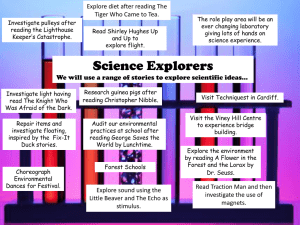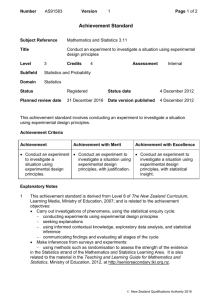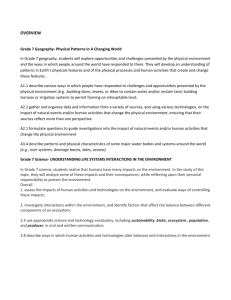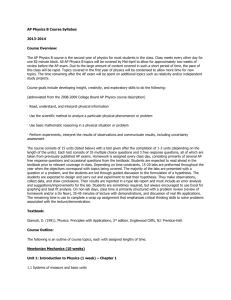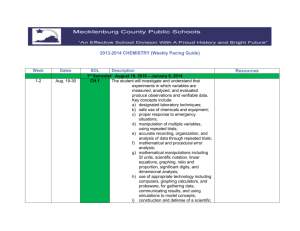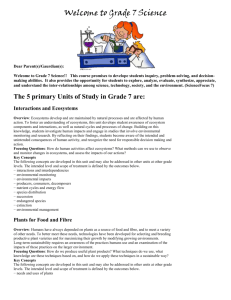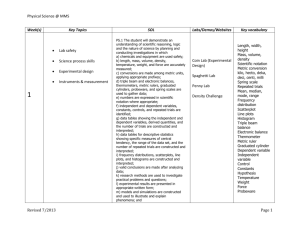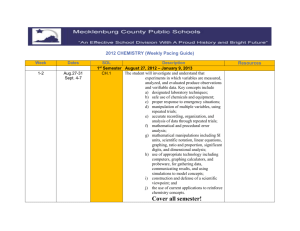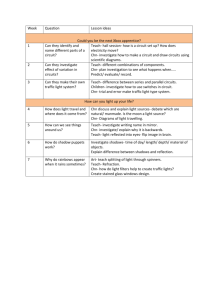DAYS - Pitt County Schools
advertisement
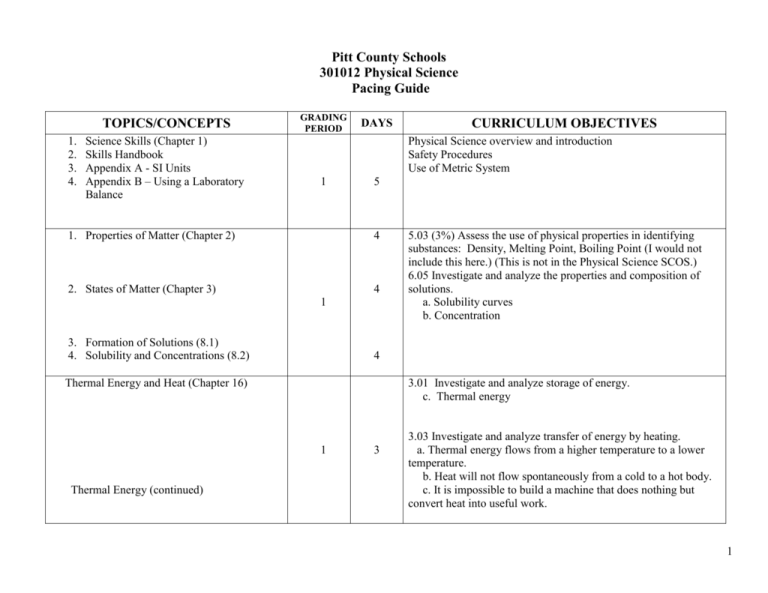
Pitt County Schools 301012 Physical Science Pacing Guide TOPICS/CONCEPTS 1. 2. 3. 4. Science Skills (Chapter 1) Skills Handbook Appendix A - SI Units Appendix B – Using a Laboratory Balance GRADING PERIOD DAYS Physical Science overview and introduction Safety Procedures Use of Metric System 1 1. Properties of Matter (Chapter 2) 5 4 2. States of Matter (Chapter 3) 4 1 3. Formation of Solutions (8.1) 4. Solubility and Concentrations (8.2) 5.03 (3%) Assess the use of physical properties in identifying substances: Density, Melting Point, Boiling Point (I would not include this here.) (This is not in the Physical Science SCOS.) 6.05 Investigate and analyze the properties and composition of solutions. a. Solubility curves b. Concentration 4 Thermal Energy and Heat (Chapter 16) 3.01 Investigate and analyze storage of energy. c. Thermal energy 1 Thermal Energy (continued) CURRICULUM OBJECTIVES 3 3.03 Investigate and analyze transfer of energy by heating. a. Thermal energy flows from a higher temperature to a lower temperature. b. Heat will not flow spontaneously from a cold to a hot body. c. It is impossible to build a machine that does nothing but convert heat into useful work. 1 Atomic Structure (Chapter 4) 4 1. The Periodic Table (Chapter 5) 2. Appendix C 3. Appendix D 1 5 SIX WEEKS TEST 1 Total Days TOPICS/CONCEPTS 1 5.01(4%) Analyze development of current atomic theory. Dalton, Thomson, Rutherford, Bohr. 5.02 (4%) Examine the nature of atomic structure; protons, neutrons, electrons, atomic mass, atomic number, isotopes 6.01 (4%) Analyze the periodic trends in the properties of elements: symbols, groups/families, periods Teacher written 30 Days GRADING PERIOD DAYS Chemical Bonds (Chapter 6) 2 6 Chemical Reactions (Chapter 7) Carbon Chemistry (Chapter 9) 2 7 Solutions, Acids, and Bases (Chapter 8) 2 4 CURRICULUM OBJECTIVES 6.02 Investigate and analyze the formation and nomenclature of simple inorganic compounds. a. Ionic bonds (including oxidation numbers). b. Covalent bonds. c. Metallic bonds. (This is not in the Physical Science SCOS.)6.03 (8%) Identify the reactants and products and balance simple equations of various types: single replacement, double replacement, decomposition, synthesis (This is not in the Physical Science SCOS.)6.03 (8%) Identify the reactants and products and balance simple equations of various types: single replacement, double replacement, decomposition, synthesis 6.04 (6%) Measure and analyze the indicators of chemical change including: development of a gas, formation of a precipitate, release/absorption of energy (Heat or light). . 6.05 Investigate and analyze the properties and composition of solutions: d. pH scale. e. Electrical conductivity. 2 Nuclear Chemistry (Chapter 10) 2 2 Motion (Chapter 11) Forces and Motion (Chapter 12) SIX WEEKS TEST 2 10 2 1 Total Days TOPICS/CONCEPTS 6.06 (2%) Describe and explain radioactivity and its practical application as an alternative energy source: alpha, beta, gamma decay, fission, fusion, nuclear waste 2.01 Measure and mathematically / graphically analyze motion: a. Frame of reference (all motion is relative – there is no motionless frame.). b. Uniform motion. c. Acceleration. 2.02 (6%) Investigate and Analyze forces as interactions that can change motion: ( Newton’s Three Laws of Motion) Teacher written 30 Days GRADING PERIOD DAYS Work, Power, and Machines (Chapter 14) Energy (Chapter 15) 3 5 CURRICULUM OBJECTIVES 3.01 Investigate and analyze storage of energy: a. Kinetic energy. b. Potential energies: gravitational, chemical, electrical, elastic, nuclear. c. Thermal energy. 3.02 Investigate and analyze transfer of energy by work. a. Force. b. Distance. Electricity (Chapter 20) Magnetism (Chapter 21) 3 12 4.01 a, b(2%) Investigate and analyze nature of static electricity and conservation of electrical charge: positive/negative charges, opposite charges attract and like charges repel. 4.01 c (4%) Analyze the electrical charging of objects due to the transfer of electrons by friction, induction, or conduction 4.02 (4%) Investigate and analyze direct current electrical circuits: electrical potential difference, resistance, Ohm’s Law, simple direct current circuits, series circuits, parallel circuits. 4.03 (4%) Investigate and analyze the practical applications of 3 magnetism Mechanical Waves and Sound (Chapter 17) The Electromagnetic Spectrum and Light (Chapter 18) 3.04 3 8 Review for EOC 3 2 All school exams 3 3 Total Days Investigate and analyze the transfer of energy by waves. a. General characteristics of waves: wavelengths, frequency, period, amplitude, velocity of propagation b. Mechanical waves. c. Sound waves. d. Electromagnetic waves (radiation). State written EOC exam 30 Days 4
